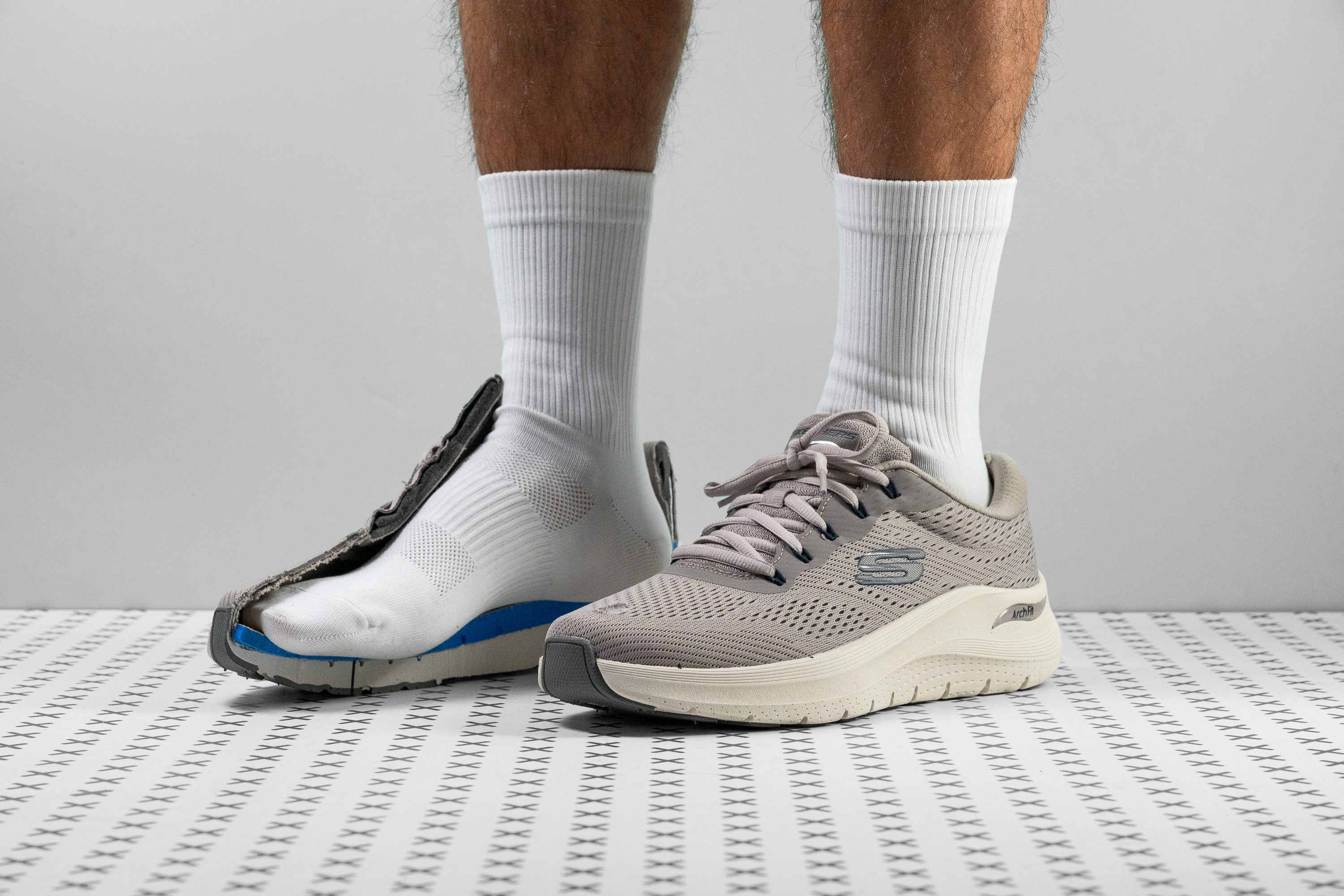Our verdict
- Top pick in best shoes for nurses
- Top pick in best walking shoes for flat feet
Pros
- Amazing support for overpronation
- Tons of cushioning
- Wide and stable platform
- Lighter than the Arch Fit 1.0
- Perfect for all-day wear
- Padded and cozy interiors
- Great traction on wet and dry surfaces
- True to size
Cons
- Very poor breathability
- Lacks durability
Audience verdict
Comparison
The most similar walking shoes compared
+ + Add a shoe | |||||
|---|---|---|---|---|---|
| Audience score | 89 Great! | 89 Great! | 92 Superb! | 86 Good! | |
| Price | $90 | $140 | $70 | $130 | |
| Arch support | Stability | Neutral | Neutral | Stability | |
| Shock absorption | High | Moderate | Moderate | Moderate | |
| Energy return | Low | Moderate | Moderate | Moderate | |
| Traction | High | Moderate | High | Moderate | |
| Condition | Flat feetOverpronationHeavy personPlantar fasciitis | Heavy personPlantar fasciitis | Heavy personPlantar fasciitis | Diabetic (A5500)Flat feetOverpronation | |
| Orthotic friendly | ✓ | ✓ | ✓ | ✓ | |
| Weight lab Weight brand | 10.9 oz / 309g | 10.3 oz / 292g 10.3 oz / 292g | 13.6 oz / 386g 13.6 oz / 386g | 13.7 oz / 388g 14.5 oz / 411g | |
| Lightweight | ✗ | ✓ | ✗ | ✗ | |
| Breathability | Warm | Breathable | Warm | Warm | |
| Use | For standing all dayCityDisneyEuropeFor nursesFor seniors | For standing all dayTravelWorkCityDisneyEuropeFitnessFor nursesTreadmill | For standing all dayCityDisneyEuropeFor nurses | WorkEuropeFor nurses | |
| Size | True to size | True to size | True to size | True to size | |
| Midsole softness | Firm | Firm | Firm | Balanced | |
| Difference in midsole softness in cold | Small | Small | Small | Small | |
| Insole thickness | Thick | Average | Average | Average | |
| Removable insole | ✓ | ✓ | ✓ | ✓ | |
| Stiffness | Moderate | Moderate | Moderate | Stiff | |
| Torsional rigidity | Moderate | Moderate | Stiff | Stiff | |
| Heel counter stiffness | Moderate | Moderate | Stiff | Moderate | |
| Heel tab | None | None | Finger loop | None | |
| Drop lab | 15.2 mm | 13.1 mm | 9.6 mm | 12.2 mm | |
| Heel stack lab | 39.2 mm | 32.9 mm | 31.7 mm | 35.7 mm | |
| Forefoot | 24.0 mm | 19.8 mm | 22.1 mm | 23.5 mm | |
| Width / fit | Medium | Medium | Medium | Narrow | |
| Toebox width | Narrow | Medium | Narrow | Narrow | |
| Closure | Laces | Laces | Laces | Laces | |
| Toebox durability | Decent | Decent | Good | Good | |
| Heel padding durability | Bad | Decent | Decent | Good | |
| Outsole durability | Bad | Good | Decent | Good | |
| Midsole width - forefoot | Average | Wide | Average | Average | |
| Midsole width - heel | Average | Wide | Average | Average | |
| Outsole hardness | Average | Average | Average | Average | |
| Outsole thickness | Average | Average | Thick | Thick | |
| Tongue padding | Average | Thin | Very thick | Thick | |
| Tongue: gusset type | None | Both sides (full) | None | None | |
| Slip-resistant | ✗ | ✗ | ✗ | ✓ | |
| Material | Mesh | Mesh | Leather | Leather | |
| Ranking | #20 Bottom 44% | #18 Top 50% | #5 Top 14% | #29 Bottom 19% | |
| Popularity | #35 Bottom 2% | #13 Top 37% | #12 Top 34% | #4 Top 12% |
Who should buy
Much like the original Skechers Arch Fit, we found the 2.0 version a highly supportive and comfortable walking shoe. We believe it is ideal for people who have flat feet, overpronation, and other foot conditions that call for podiatrist-approved footwear.
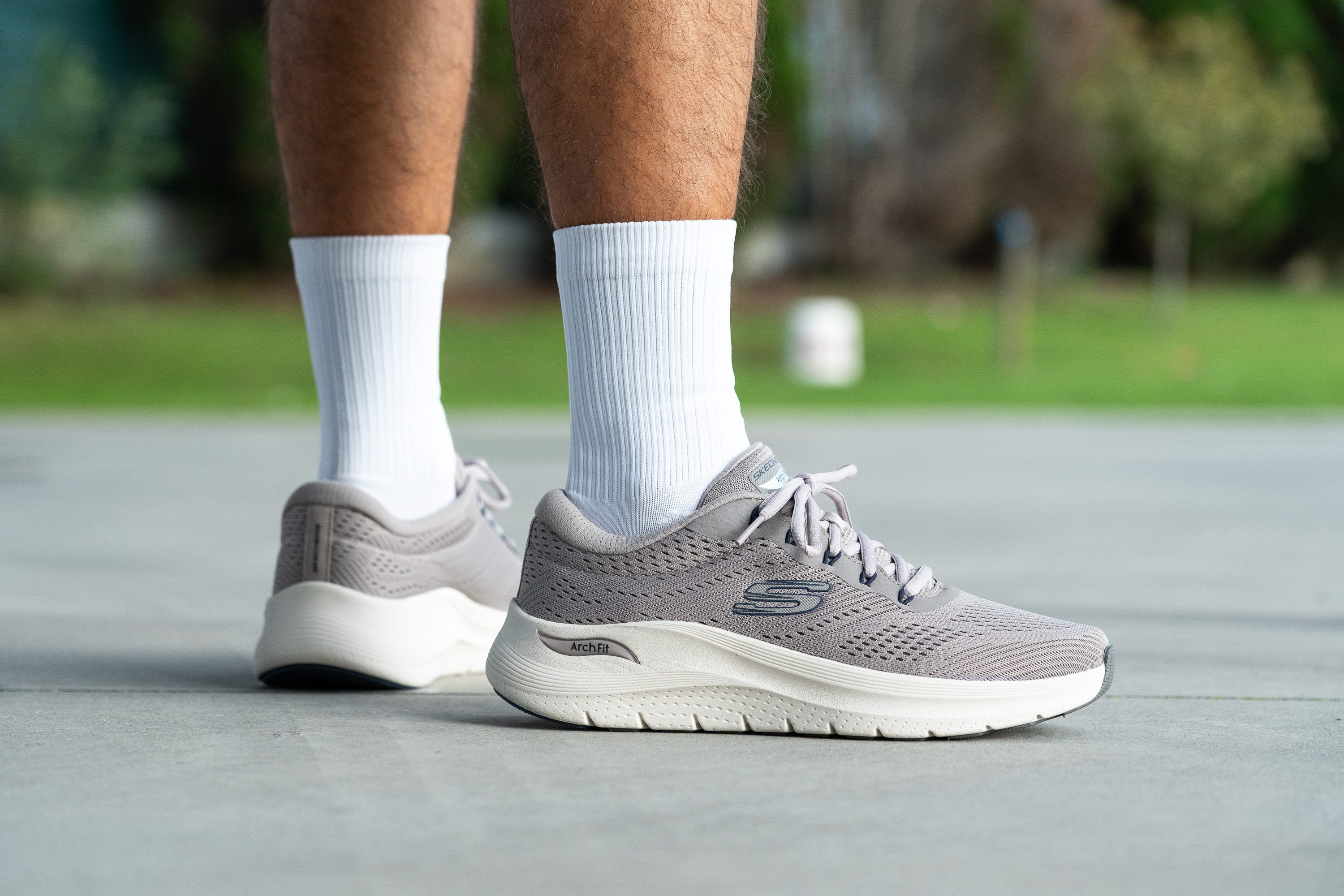
Who should NOT buy
Given the shoe's fairly warm upper, we think that it's more suitable for temperatures between 50°F (10°C) and 70°F (20°C). So, if you need better breathability for summertime, we recommend the Skechers Max Cushioning Arch Fit.
And if, like us, you are turned off by the shoe's lack of wear resistance, you will also find the Max Cushioning Arch Fit more reassuring. Or invest in a more expensive option like the Hoka Transport.
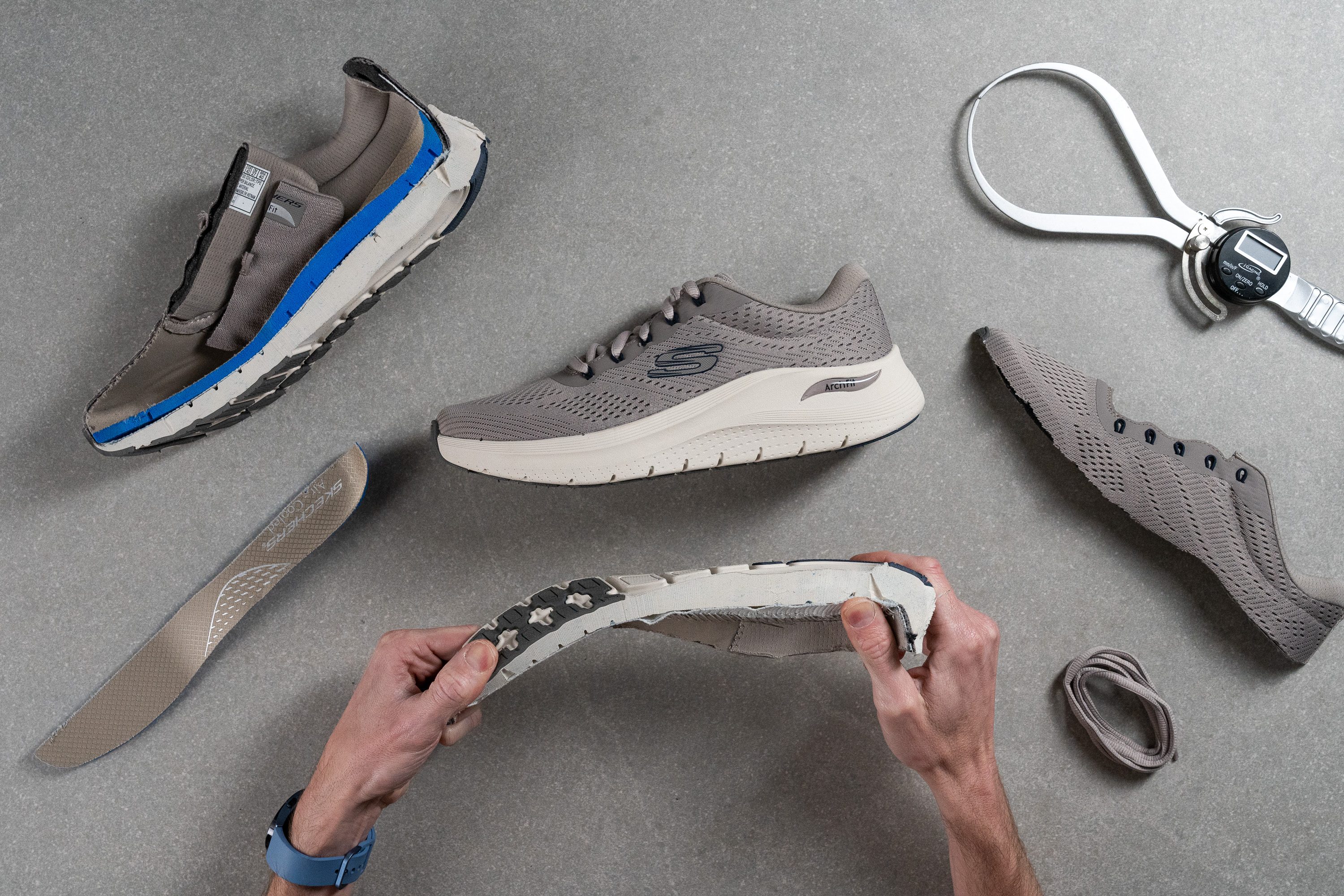
Cushioning
Shock absorption
Walking shoes from Skechers keep setting new cushioning records in our lab! This time, the Arch Fit 2.0 showed an exceptionally high shock absorption reading of 134 SA, undercutting more expensive walking and running shoes with advanced cushioning technologies!
The shoe feels luxuriously comfortable for all-day wear, reducing fatigue and stress on the joints to an absolute minimum.

| Arch Fit 2.0 | 134 SA |
| Average | 111 SA |
Energy return
The Arch Fit 2.0 absorbs a ton of impact but it doesn't give much energy back to the foot. Measuring its energy return at only 43%, our test confirmed the shoe's low-rebound ride.
However, that lack of springback didn't detract from this Skechers shoe's overall comfort and only added stability to the underfoot experience.
| Arch Fit 2.0 | 43.0% |
| Average | 51.1% |
Heel stack
One thing that remained unchanged in the Arch Fit 2.0 is the copious amount of cushioning. It is THE tallest platform among our lab-tested walking shoes so far.
Measuring the shoe's heel stack with a caliper, we got a whopping 39.2 mm! This is significantly thicker than average and gives the wearer a good height advantage.
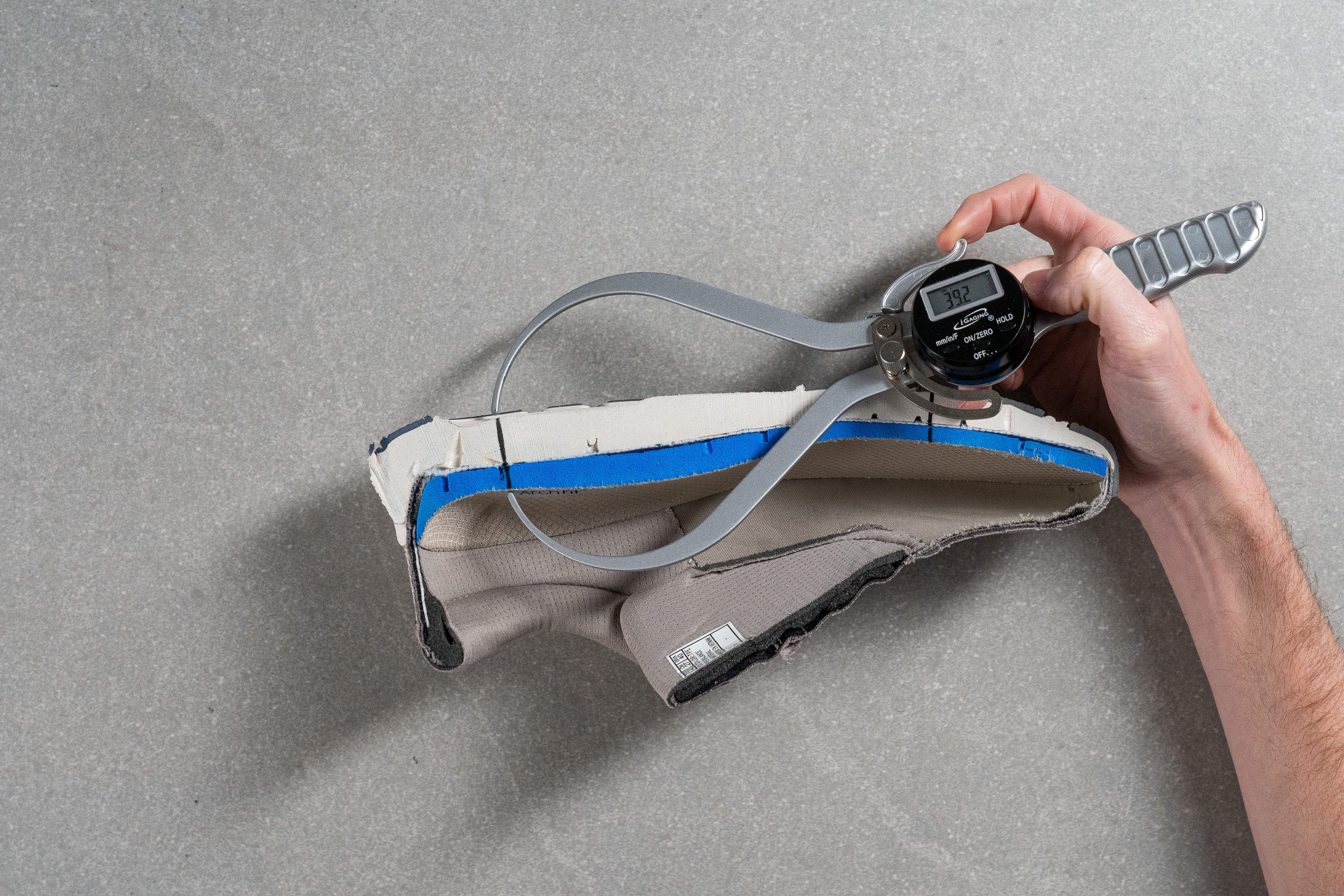
But what's most important about this cushioning is its ability to support our feet for very long hours!
| Arch Fit 2.0 | 39.2 mm |
| Average | 32.3 mm |
Forefoot stack
But this Skechers shoe is not only super cushioned in the heel, it also turns out to be thicker than average in the forefoot!
Measuring stack height in this area, we got 24.0 mm on the caliper. This is, again, a bit taller than average. We experienced nothing but comfort in this thick-foamed beater.
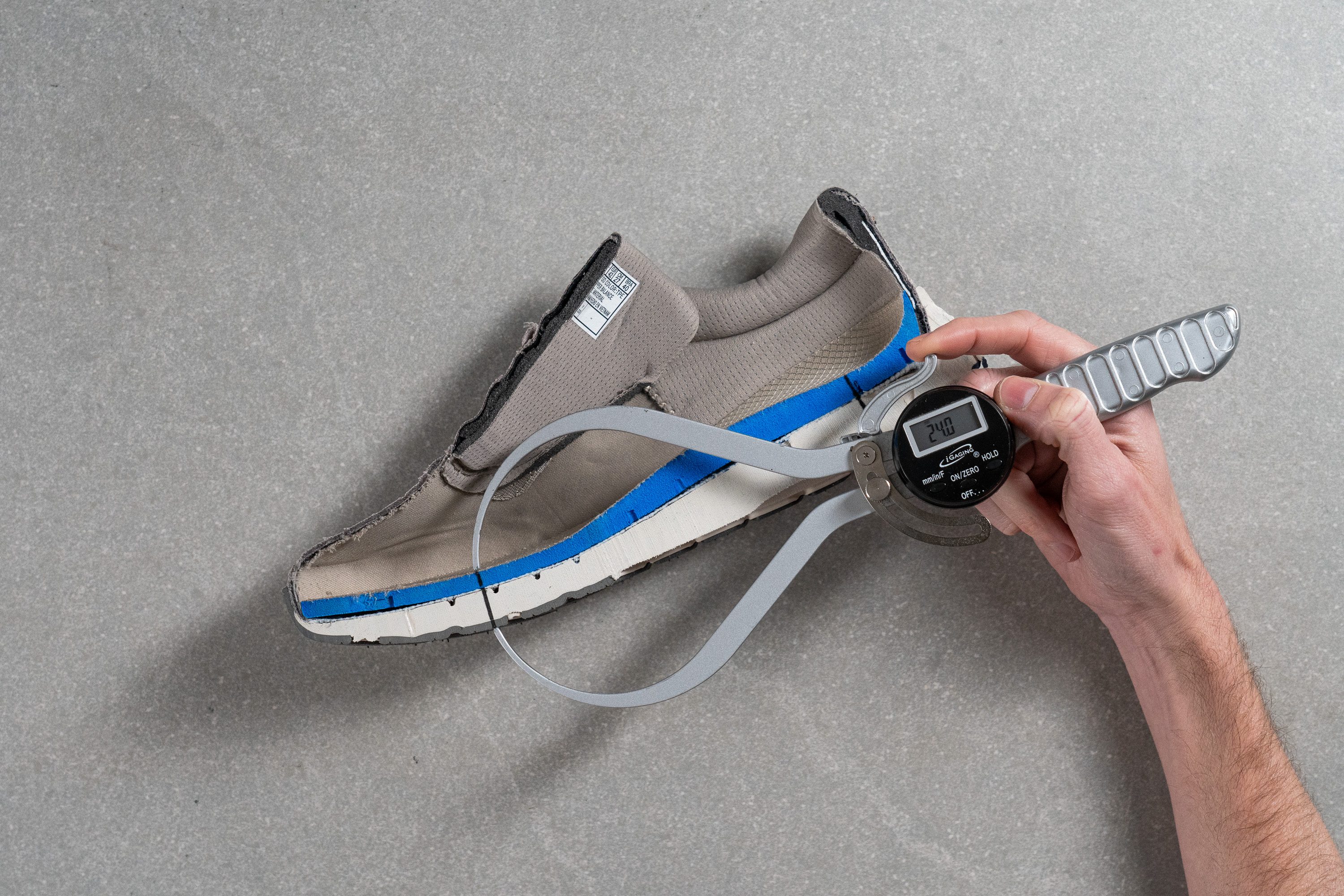
| Arch Fit 2.0 | 24.0 mm |
| Average | 21.9 mm |
Drop
The difference in height between the heel and the forefoot stack results in a drop of 15.2 mm. It is nearly identical to the drop on the original Arch Fit, so the feel was very familiar.
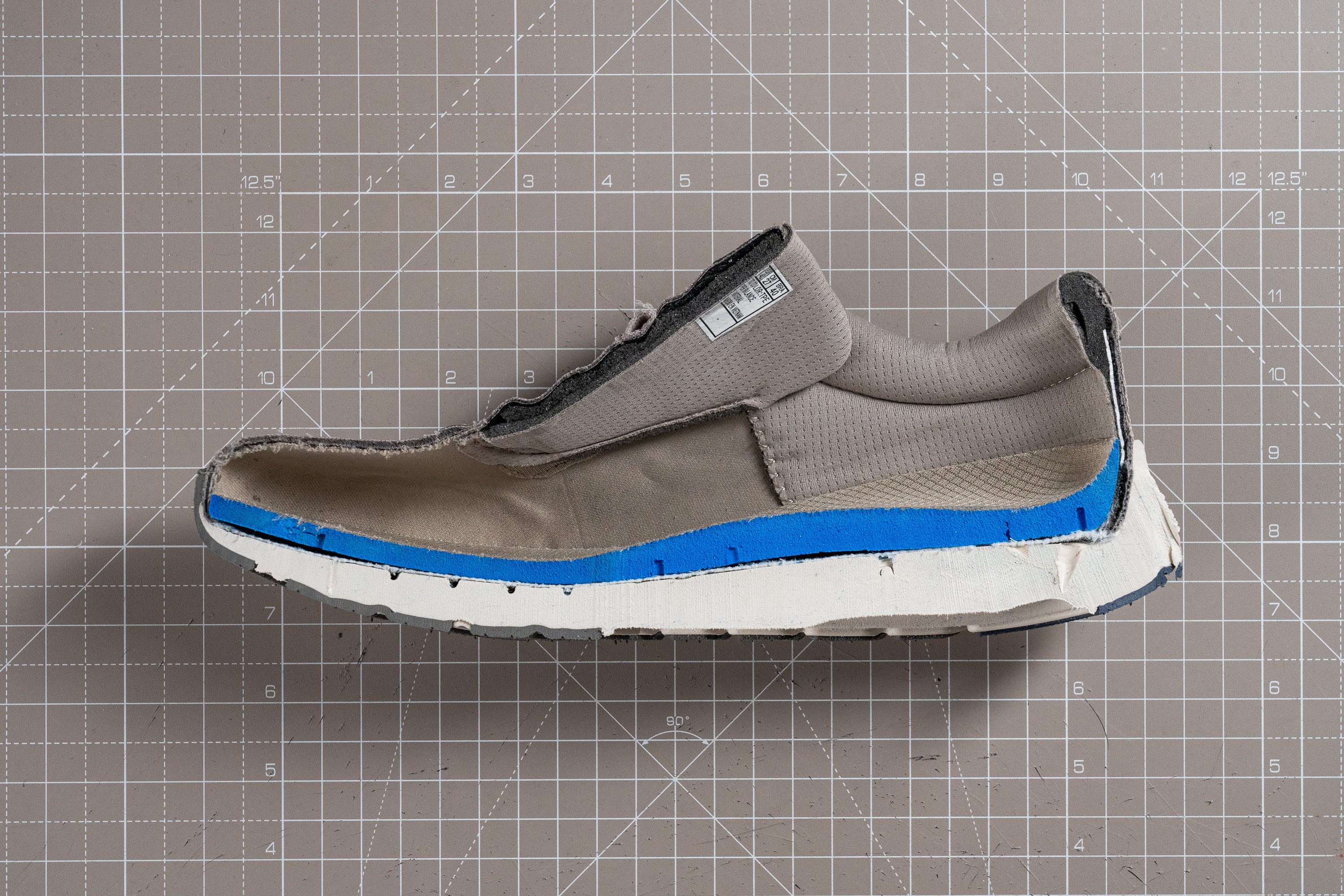
Because the shoe's primary purpose is to provide support, it relies on a higher drop to relieve some of the stress and strain from your ankles and Achilles. Plus, you feel the extra impact protection as you repetitively land on your heels when walking.
| Arch Fit 2.0 | 15.2 mm |
| Average | 10.4 mm |
Midsole softness
Assessing the shoe's cushioning softness on the foot, we really couldn't tell the difference with the original shoe. Even with one of each Skechers shoe on our feet.
Both feel soft enough to feel comfortable but also slightly firm for support.
Turning to our durometer, we measured the Arch Fit 2.0's foam at 30.4 HA. That's 20% firmer than the average walking shoe and definitely not a plush one.
And this is exactly what you need in a supportive shoe that can help flat feet, overpronation, and even conditions like plantar fasciitis.
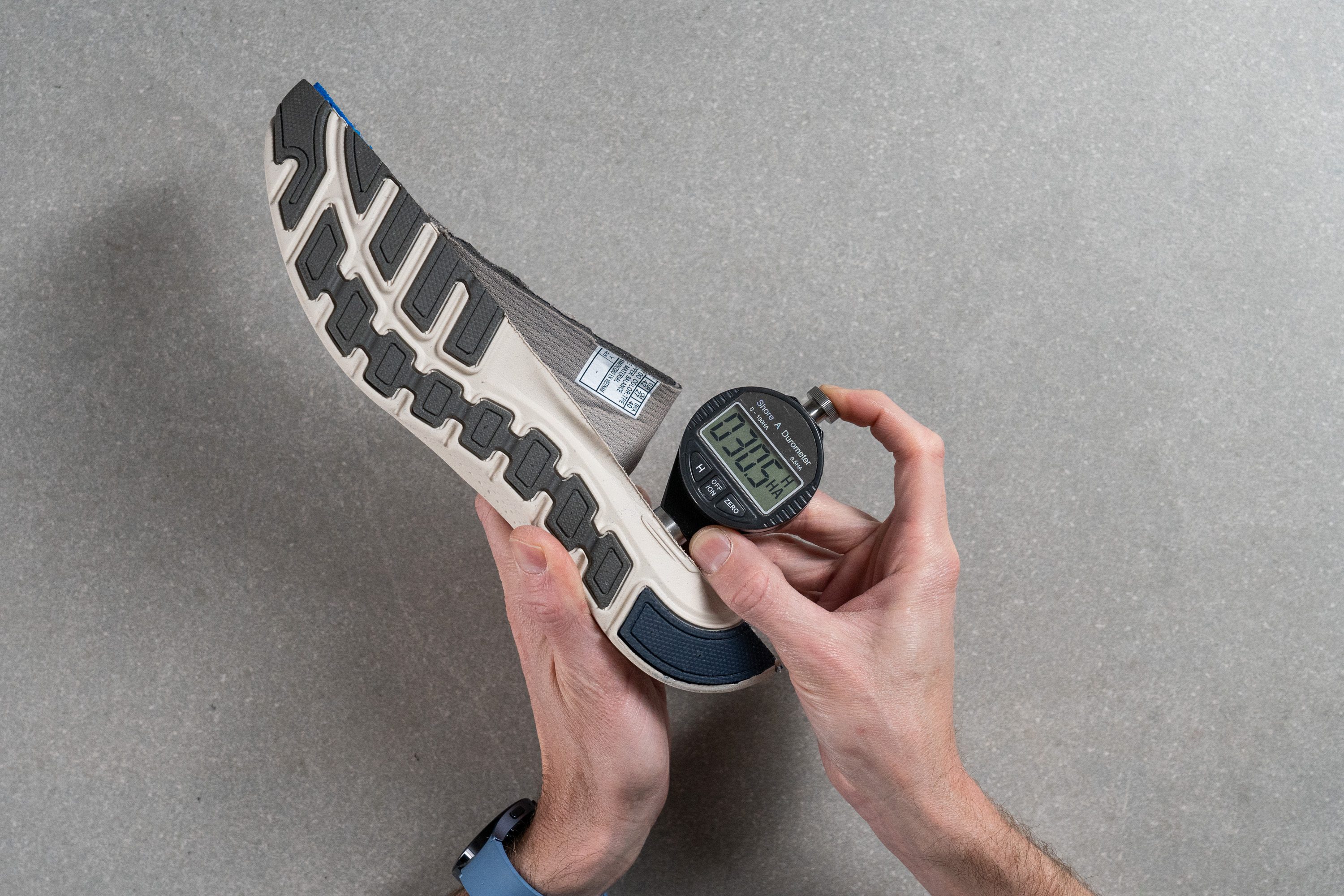
| Arch Fit 2.0 | 30.4 HA |
| Average | 26.4 HA |
Rocker
There's been a real craze with rocker-bottom shoes lately! Just look at the Nike Motiva for example.
But Skechers skips that in favor of stability in the Arch Fit 2.0 and we think it's a wise idea. The shoe's midsole is only slightly curved at the heel and forefoot to smoothen heel-to-toe transitions a little bit.
You need a stable platform if you try to relieve painful conditions!
Size and fit
Size
Skechers Arch Fit 2.0 fits true to size (85 votes).
Width / Fit
Using a proprietary gel, we retrieved the mold of the shoe's interiors to see how it measures against the average in a men's US size 9 (D medium width).
Our caliper showed a standard width of 94.6 mm between the widest points of the mold (first and fifth metatarsals of the foot).
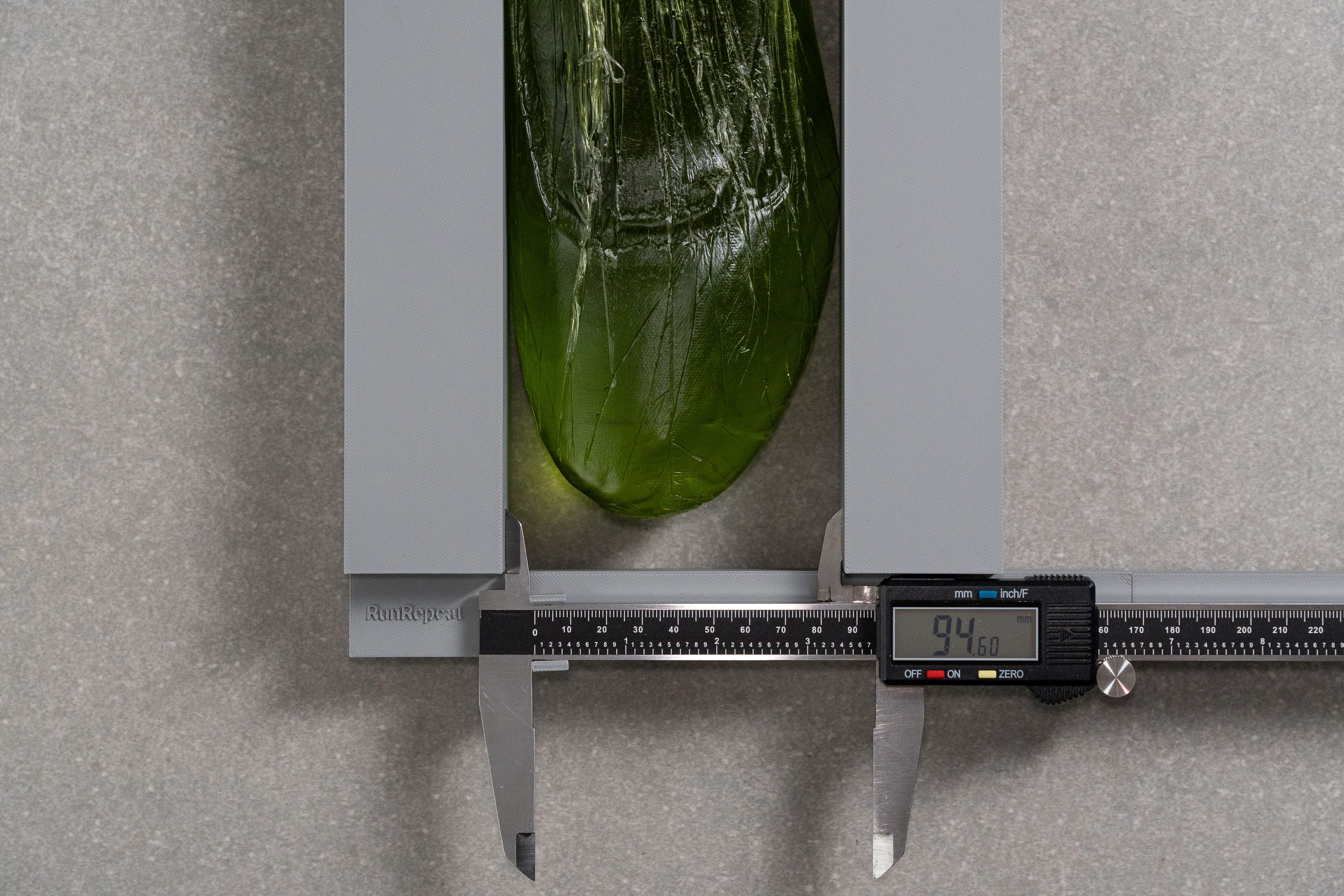
Paired with the shoe's moderately stretchy upper fabric, it creates a close-fitting but not constricting fit for someone with medium feet.
| Arch Fit 2.0 | 94.6 mm |
| Average | 94.4 mm |
Toebox width
Applying our caliper to the big toe area of the mold, we measured 68.3 mm which is narrower than the average of walking shoes.
If you have wider feet or need more space to accommodate toe swelling, bunions, or other foot conditions, some of the shoe's colorways are also offered in wide and extra-wide options.
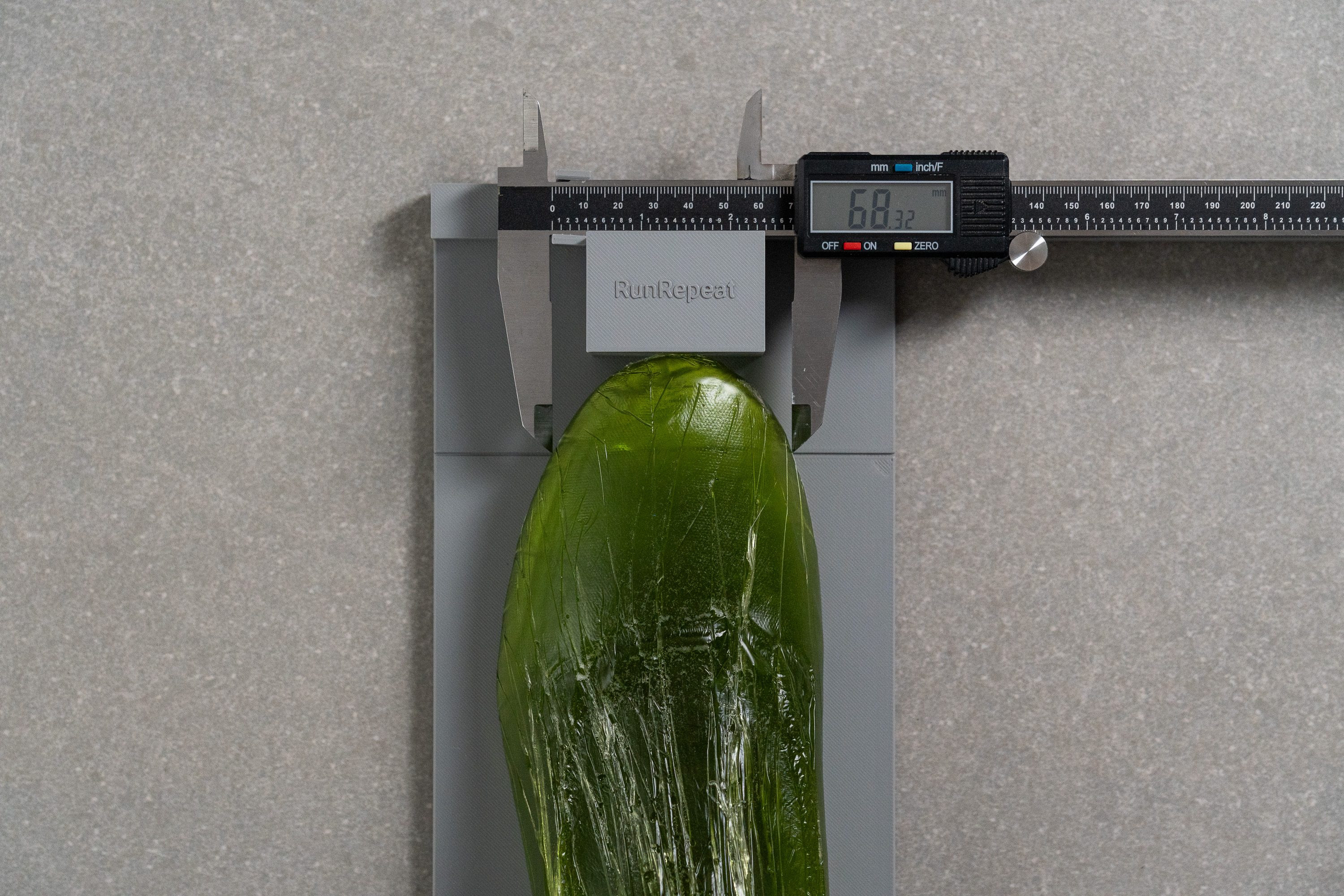
| Arch Fit 2.0 | 68.3 mm |
| Average | 71.2 mm |
Toebox height
We found no deviations in the toebox height of the Arch Fit 2.0. At 25.6 mm it is on par with the average.
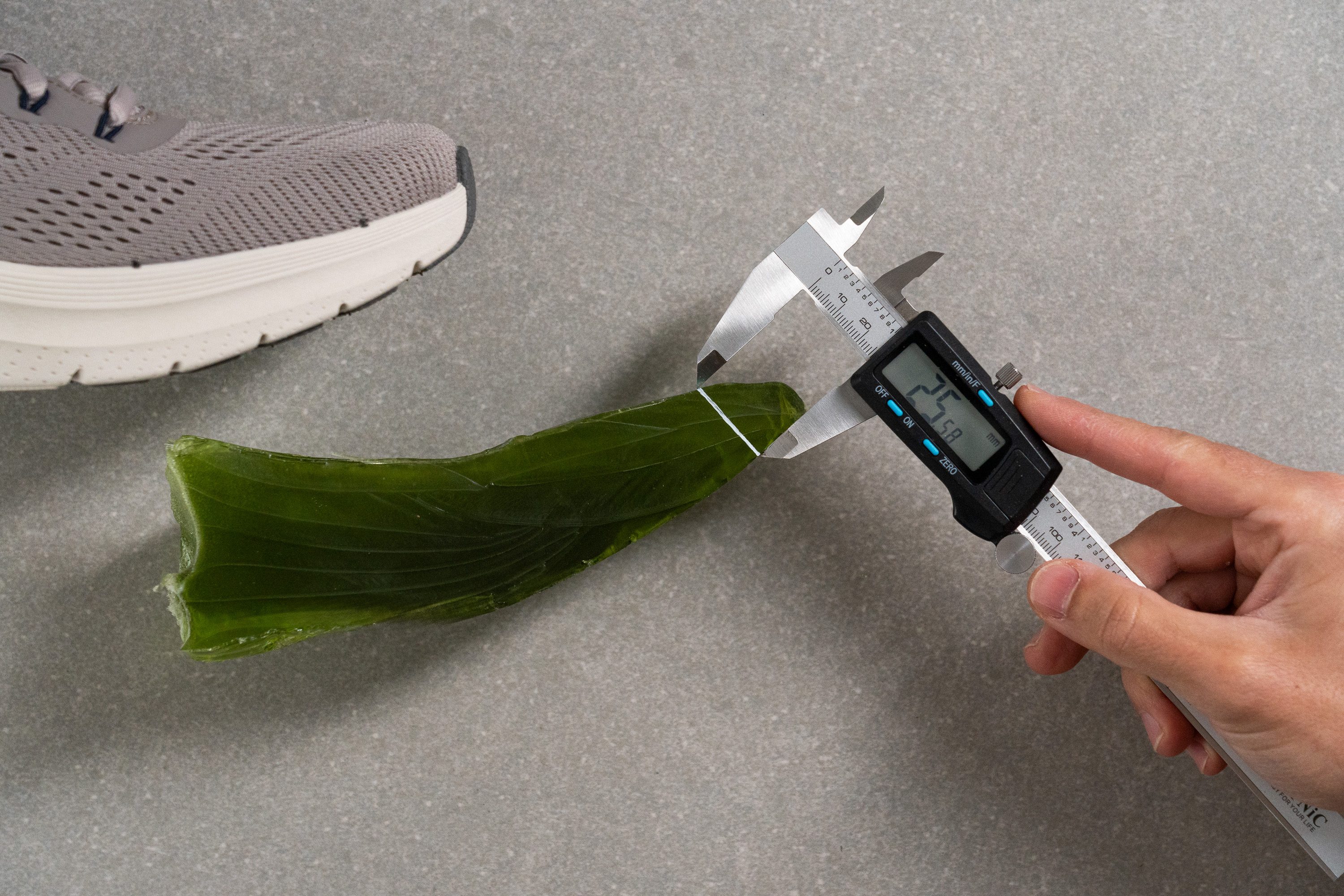
| Arch Fit 2.0 | 25.6 mm |
| Average | 26.4 mm |
Traction / Grip
Traction test
Skechers changed the outsole configuration of the Arch Fit 2.0 which significantly improved the grip compared to the original Arch Fit shoe.
The newer edition showed much better heel friction as our grip testing machine smashed it against wet concrete at a 7-degree angle and a 500N force (imitating heel landing). The coefficient came in at 0.45 which is notably higher than the older shoe's 0.36.
So if you ever wished for a better grip on wet sidewalks in the older Arch Fit shoes, this is a more confidence-inspiring option.
| Arch Fit 2.0 | 0.45 |
| Average | 0.46 |
Outsole design
Skechers have made some quality changes to the Arch Fit's outsole which helped to elevate its grip but, unfortunately, the same cannot be said about its rubber durability (see Outsole durability section below).

Flexibility / Stiffness
With a bit more emphasis on stability, the Skechers Arch Fit 2.0 lost a little bit of flexibility too. But don't worry, the flex grooves throughout its platform still let the shoe bend with the foot a necessary amount.
To measure exactly how flexible this Skechers shoe is, we used a specialized shoe flexing tester to bend it by 30 degrees. The machine then showed that it took 13.4N to do that. That's just as much as it takes an average walking shoe.
So, indeed, the Arch Fit 2.0 stiffened up a bit to provide a more stable experience.
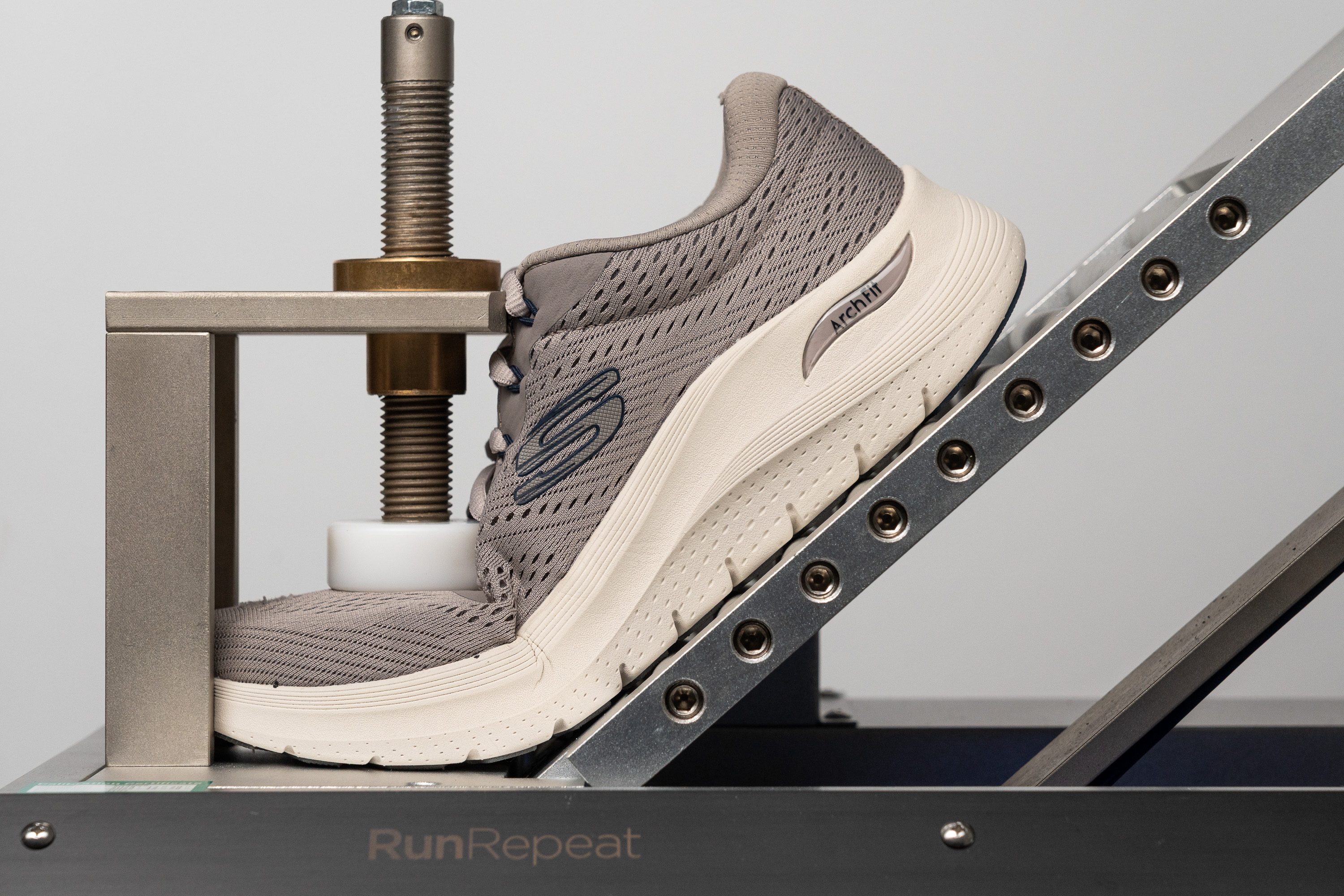
| Arch Fit 2.0 | 13.4N |
| Average | 13.9N |
Weight
But luckily, the Skechers Arch Fit 2.0 still carries some good news. It lost as much as 1.8 oz (51g)! Now that's impressive!

The shoe now tips the scale at only 10.9 oz (309g) as opposed to the hefty 12.5 oz (353g) of its predecessor! We must admit that despite the visual bulk, it feels weightless on the foot!
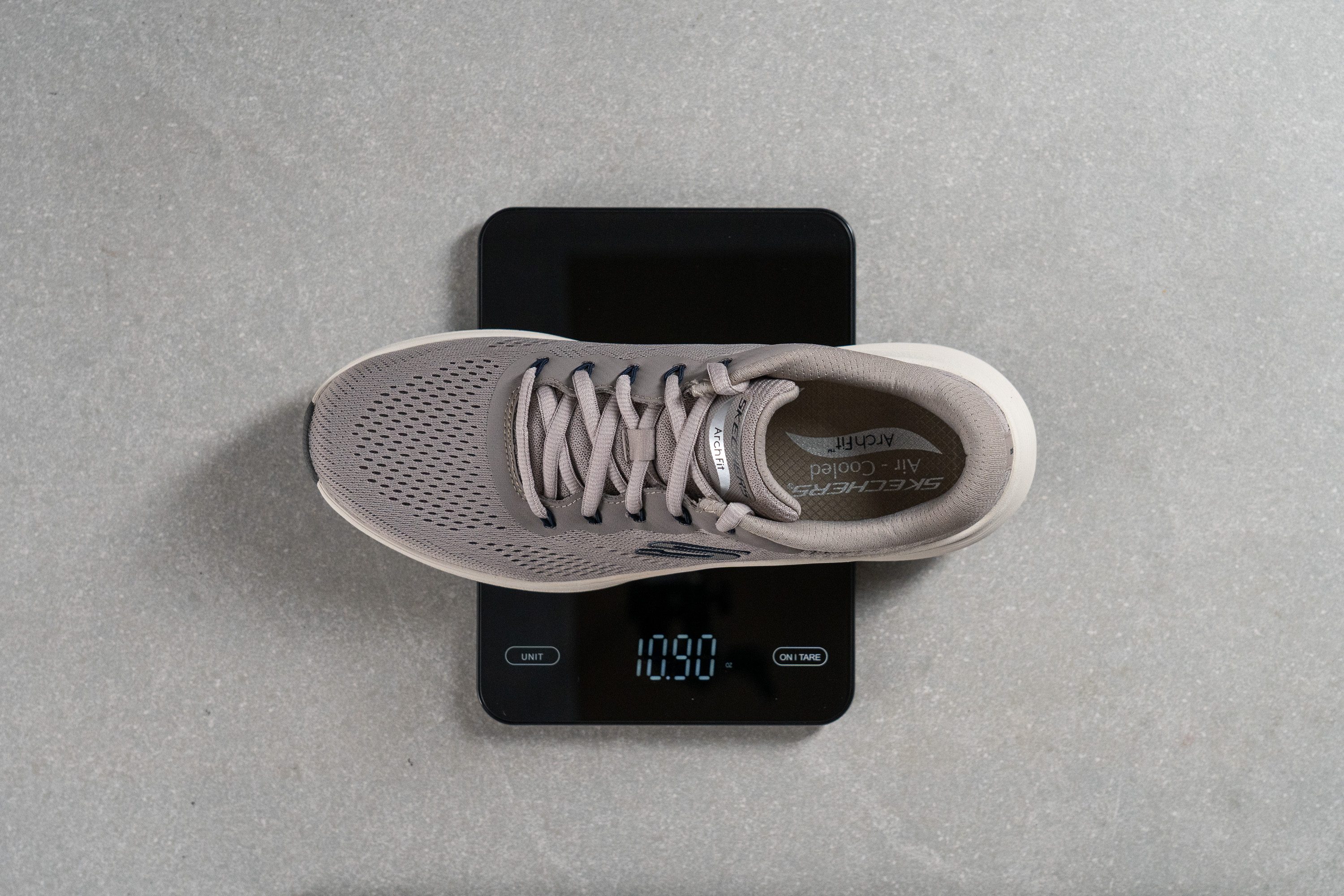
| Arch Fit 2.0 | 10.9 oz (309g) |
| Average | 10.2 oz (288g) |
Breathability
The first edition of the Arch Fit wasn't a highly breathable shoe to begin with. And to our great disappointment, it got even worse in the 2.0.
Wearing this shoe on warm summer days, we ended up with damp socks and feet every time!
Back in the lab, we tested this Skechers shoe's ventilation with a smoke-pumping machine. Filling its upper with smoke from the inside, we observed how very slowly and reluctantly it came out on the other side.
On a breathability scale from 1 to 5, we gave it a sad rating of 2.
To give you even more visual proof, we hovered the shoe's half-cut upper over a bright light. It is shocking how NONE of those ventilation holes let the light shine through!
We also took a closer look at the upper fabric through our microscope.

It revealed that beneath those large pores, we've got even more layers of fabric as well as thick in-shoe lining.

| Arch Fit 2.0 | 2 |
| Average | 2.9 |
Stability
Lateral stability test
And stability is exactly this Skechers shoe's forte.
As you can see in the video below, the sho responds to our ankle shifting by firmly keeping it planted on the ground. Amazing support!
Considering the shoe's extra tall stack, such stability is absolutely necessary to prevent the ankle from rolling over the shoe's edge.
Torsional rigidity
Twisting the shoe in our manual test, we did notice that it got stiffer than its predecessor. Not by too much but just enough to bump up the torsional rigidity score from 2 to 3! And that's on a 1-5 scale, where 5 is the stiffest.
We assume that it could be due to the slightly altered geometry of the midsole. Its sidewalls appear a bit taller.

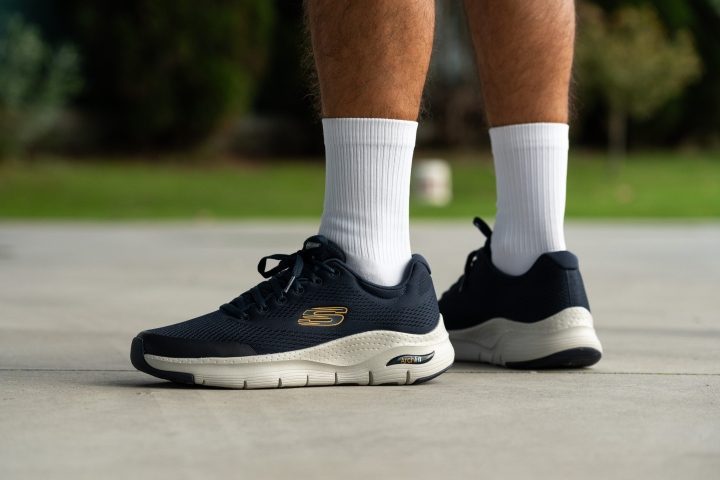
| Arch Fit 2.0 | 3 |
| Average | 2.9 |
Heel counter stiffness
As for the shoe's heel counter, it remained just as moderately stiff as in the predecessor. Together with the collar padding, it held our heel very securely without restricting the ankle or Achilles.
We gave it a score of 3 on the stiffness scale of 1 to 5.
| Arch Fit 2.0 | 3 |
| Average | 2.4 |
Midsole width - forefoot
The shape of the platform is pretty much identical in the two Arch Fit versions. Which is great news!
We found the first shoe's extended ground contact points extremely stable underfoot and are happy to experience the same in the 2.0.
According to our caliper, the distance between the widest points of the forefoot is 114.5 mm. A bit wider than average!

| Arch Fit 2.0 | 114.5 mm |
| Average | 112.0 mm |
Midsole width - heel
Meanwhile, the widest part of the shoe's platform in the heel is 90.9 mm. Also plenty of landing area for someone who relies heavily on supportive shoes.
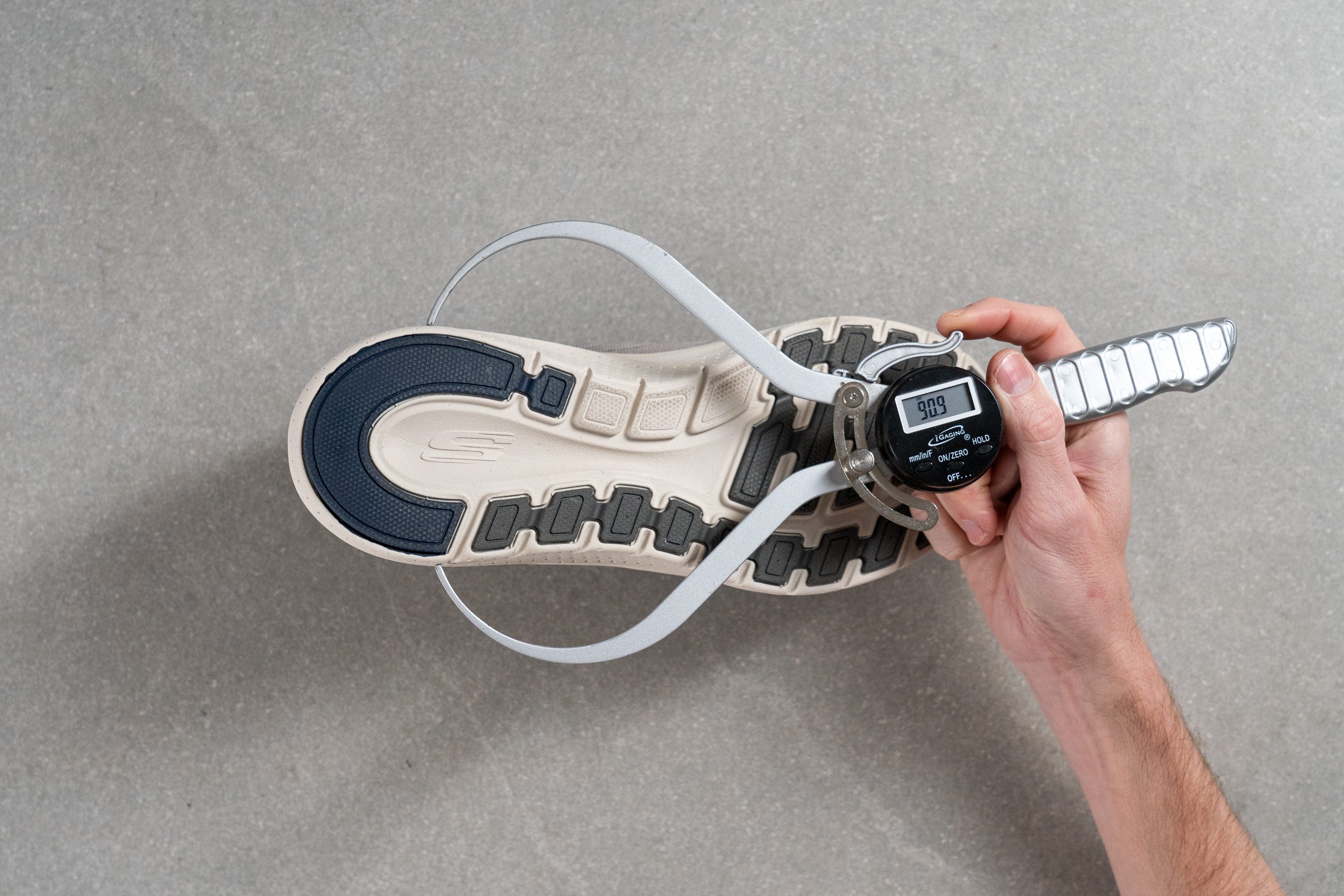
| Arch Fit 2.0 | 90.9 mm |
| Average | 90.3 mm |
Durability
Toebox durability
Alright, we can save this shoe for cooler weather but do we at least get a more wear-resistant upper in return?
Unfortunately, no.
The fabric got even more prone to tearing in the Arch Fit 2.0, as our in-house durability test shows. For context, it is the exact same test with the exact same conditions: 12 seconds of pressing the Dremel against the same spot on the toebox, with the same speed (5K RPM) and pressure (3.2N).
Given that the tool's sandpaper tip cut almost entirely through the upper, we had to give the toebox a very low durability score of 2 out of 5. For reference, the original Arch Fit at least got 3!

| Arch Fit 2.0 | 2 |
| Average | 3.2 |
Heel padding durability
Sadly, the material quality of the collar padding and lining got worse as well... And it wasn't the best quality in the original either.
It only took 4 seconds of drilling to wreak havoc on the inside of the shoe's heel padding.
The tool went all the way through the collar padding and left a glaring hole. On a 1-5 scale, where 5 is the most durable, the Skechers Arch Fit 2.0 gets the lowest score for heel padding durability.
You can see what a 5-score durability looks like in the shoe on the right.
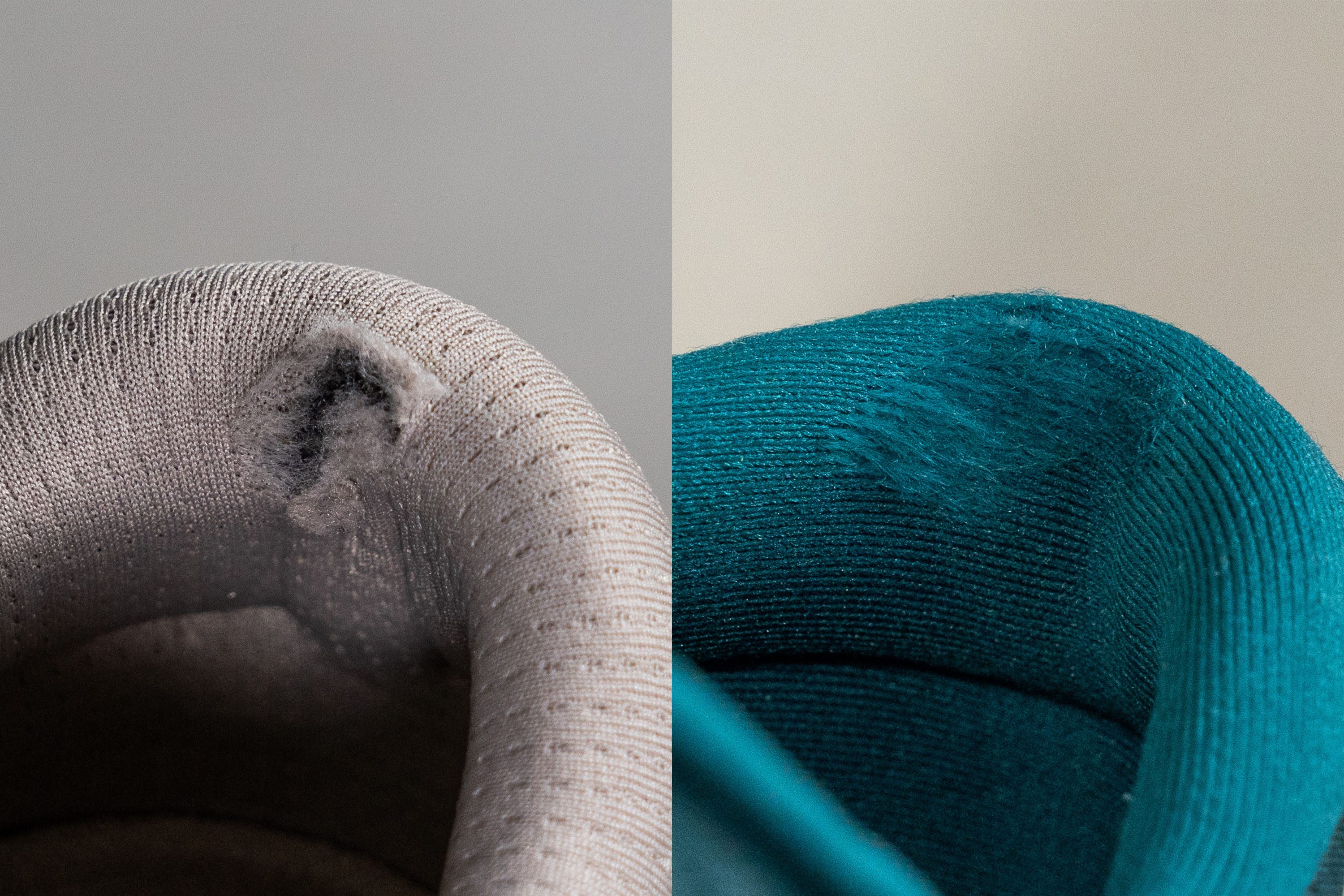
| Arch Fit 2.0 | 1 |
| Average | 2.3 |
Outsole hardness
At the bottom, this Skechers shoe protects the most hard-wearing parts with rubber. Measuring it with a durometer, we got an above-average reading of 85.9 HC.
Normally, harder compounds tend to be more durable but, unfortunately, not in the case of the Arch Fit 2.0.

| Arch Fit 2.0 | 85.9 HC |
| Average | 78.0 HC |
Outsole durability
We applied the Dremel to one of the shoe's rubber-covered areas for 22 seconds at a higher speed of 10K RPM. And to be honest, Skechers didn't even have to bother with rubber because it just melted under our Dremel much like the foam would.
Even before measuring the damage with a tread gauge, we could see that it was much worse than average. And when the tool showed a whopping 2.4 mm of depth, we weren't surprised.
Most walking shoes with rubber outsoles get no more than 1-1.5 mm of damage. And the kicker is, the original Arch Fit only got 0.7 mm!
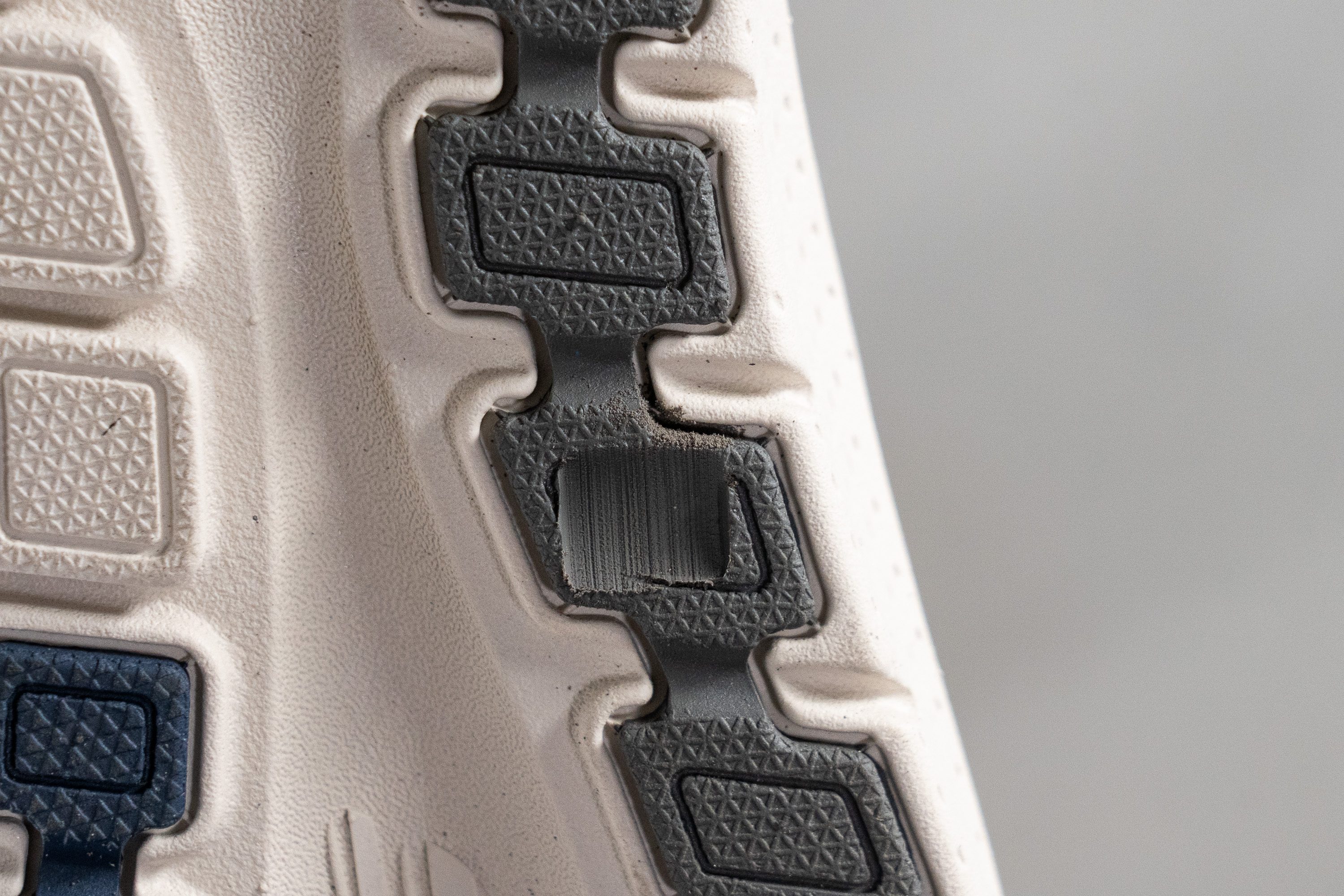
| Arch Fit 2.0 | 2.4 mm |
| Average | 1.4 mm |
Outsole thickness
At least the rubber is decently thick at 2.6 mm. So, it will help the outsole hold up for a while before the pavement touches exposed foam.
Sure, we can't expect a lot for $90 but having tried the first Arch Fit, we were very much underwhelmed with the update.

| Arch Fit 2.0 | 2.6 mm |
| Average | 3.0 mm |
Misc
Insole thickness
It seems like Skechers kept the same insole design as in the original Arch Fit. And we are very happy with this fact! Our feet thoroughly enjoyed the generously padded and contoured feel of that insole.
Measuring its thickness with a caliper, we couldn't help but notice that it was more padded than average at 9.8 mm!
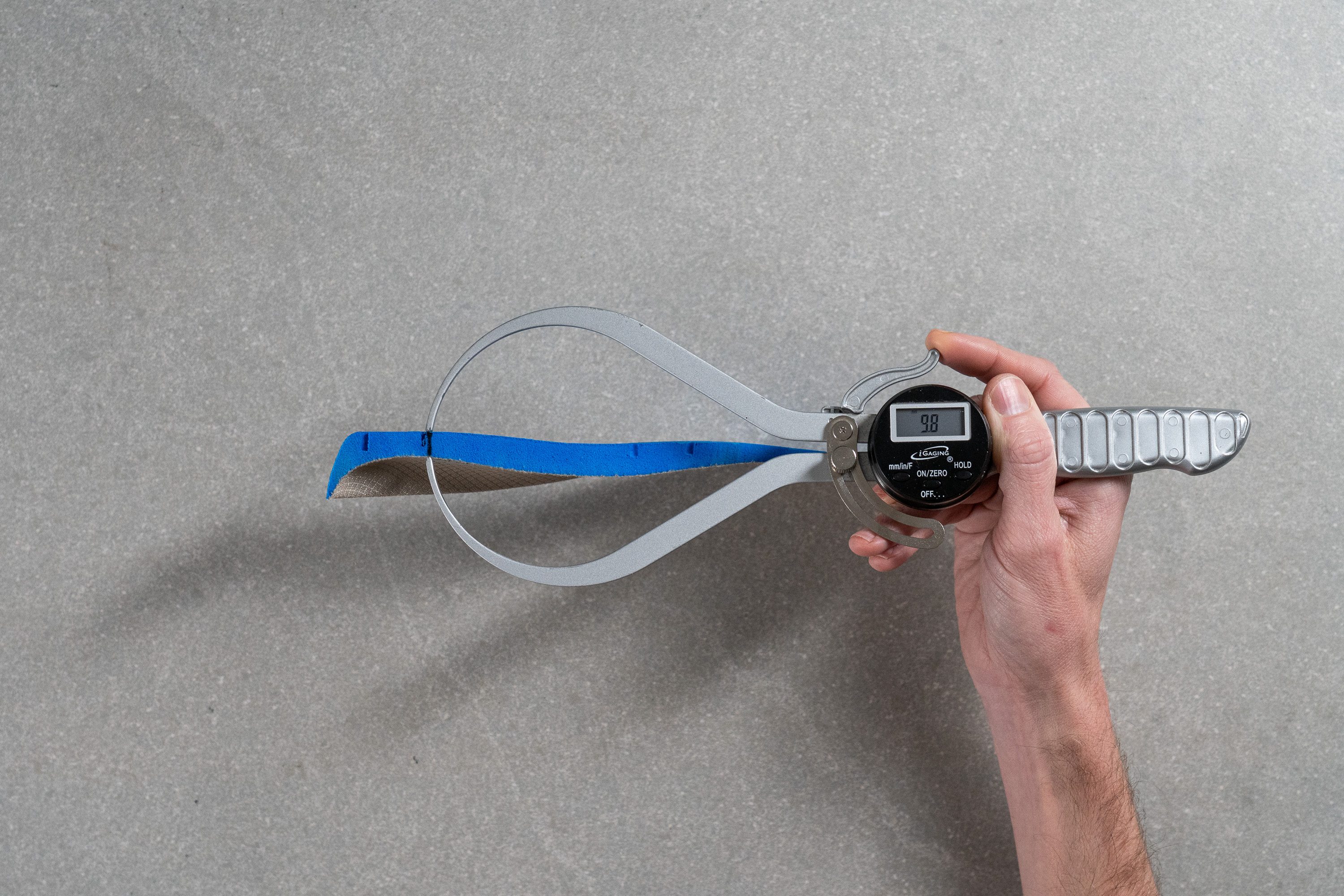
| Arch Fit 2.0 | 9.8 mm |
| Average | 5.8 mm |
Removable insole
Experiencing the contoured insole on the Arch Fit 2.0, we could understand why it was approved by podiatrists. It is removable in case you want to use your own orthotics, but we really don't see the point in it. It is that good.
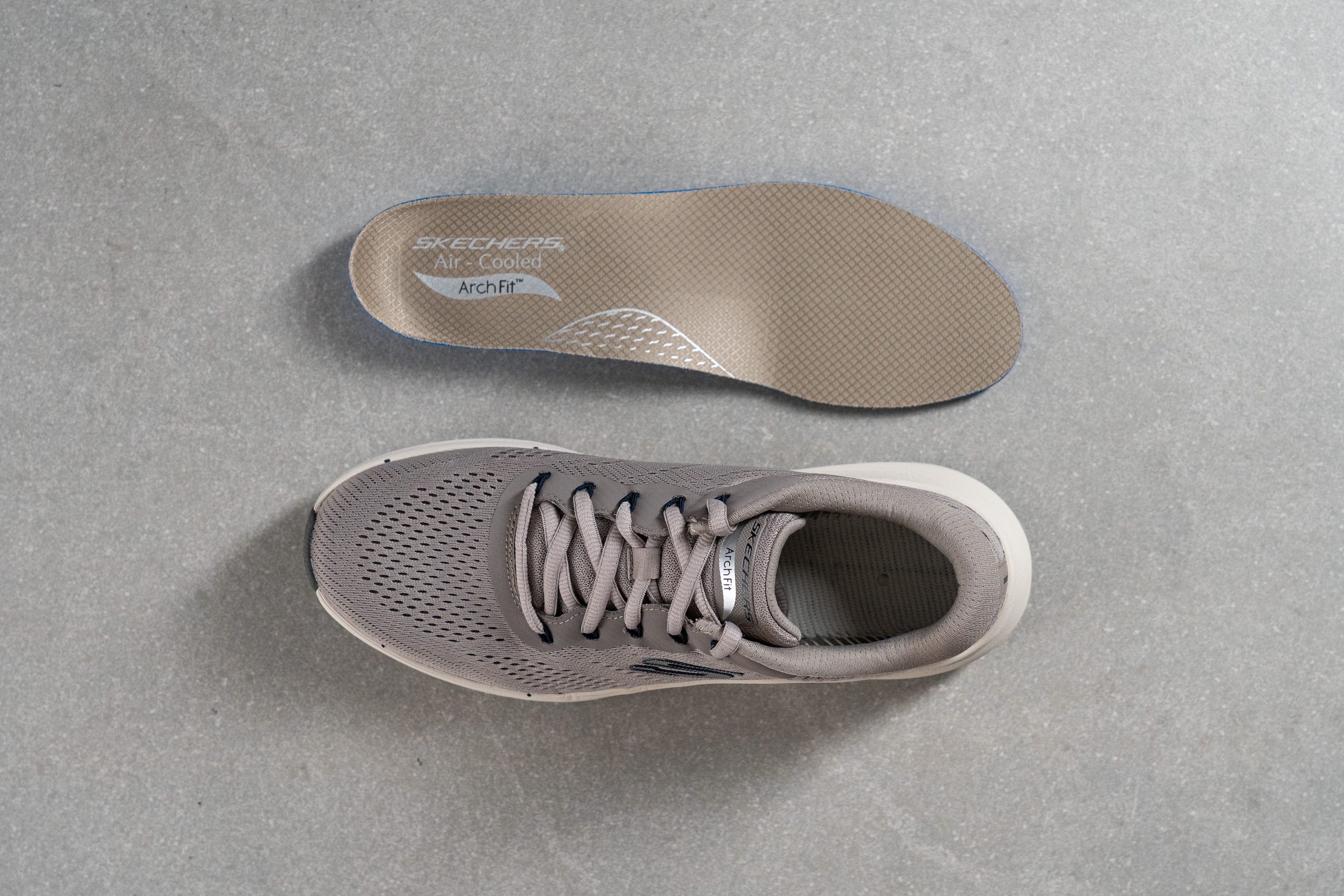
| Arch Fit 2.0 | Yes |
Tongue padding
When we say padding, we mean very generous padding. As our caliper shows, the thickness of this shoe's tongue is 8.0 mm which is notably thicker than average.
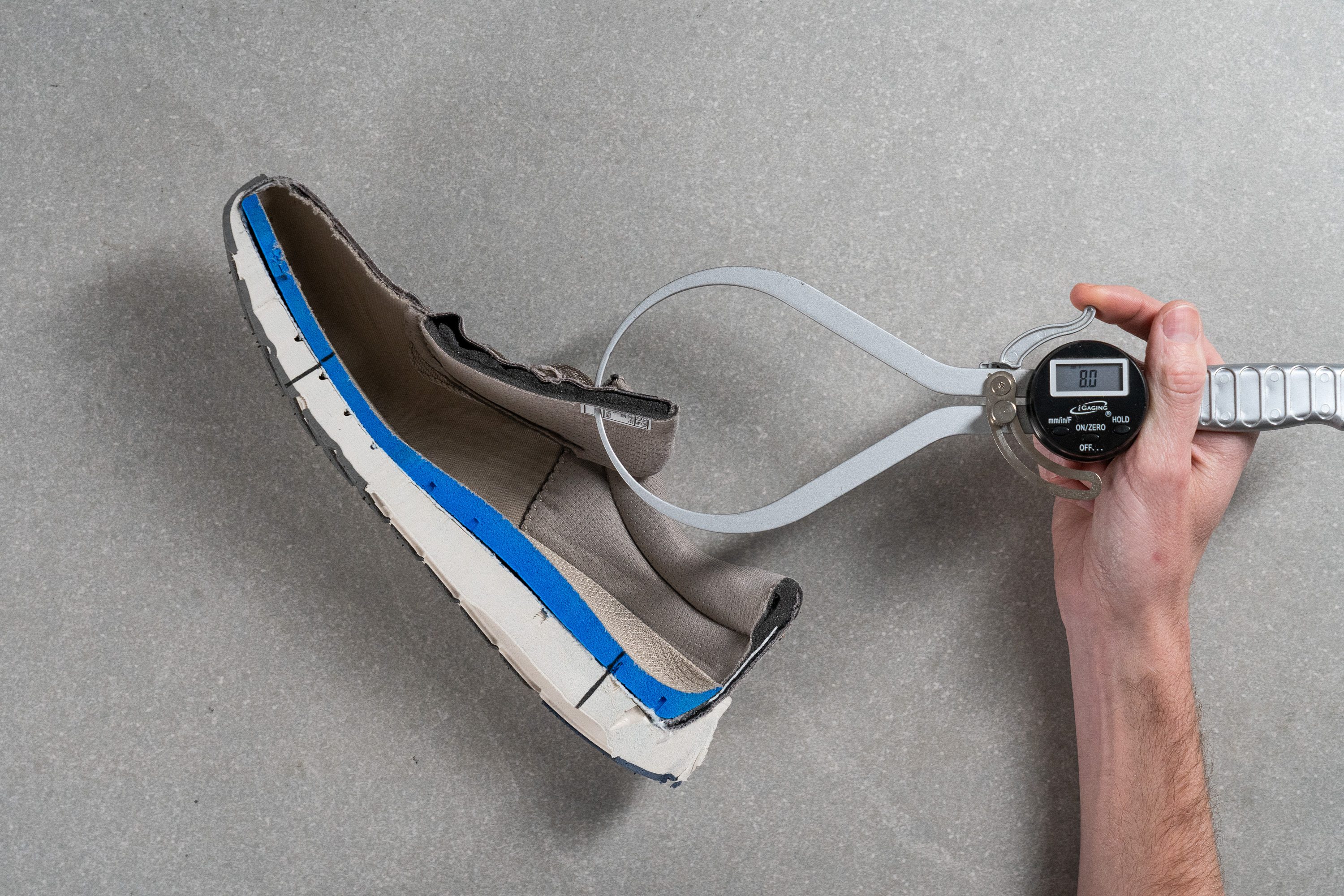
| Arch Fit 2.0 | 8.0 mm |
| Average | 5.6 mm |
Tongue: gusset type
Like most budget-friendly shoes, the Skechers Arch Fit 2.0, features a regular tongue with no attachments on the sides.
But the shape and padding of the tongue helped to prevent it from shifting sideways uncontrollably.

| Arch Fit 2.0 | None |
Heel tab
There is no heel tab to hold onto when getting the shoe on. But we found the on-and-off action fairly in the Arch Fit 2.0 anyway.
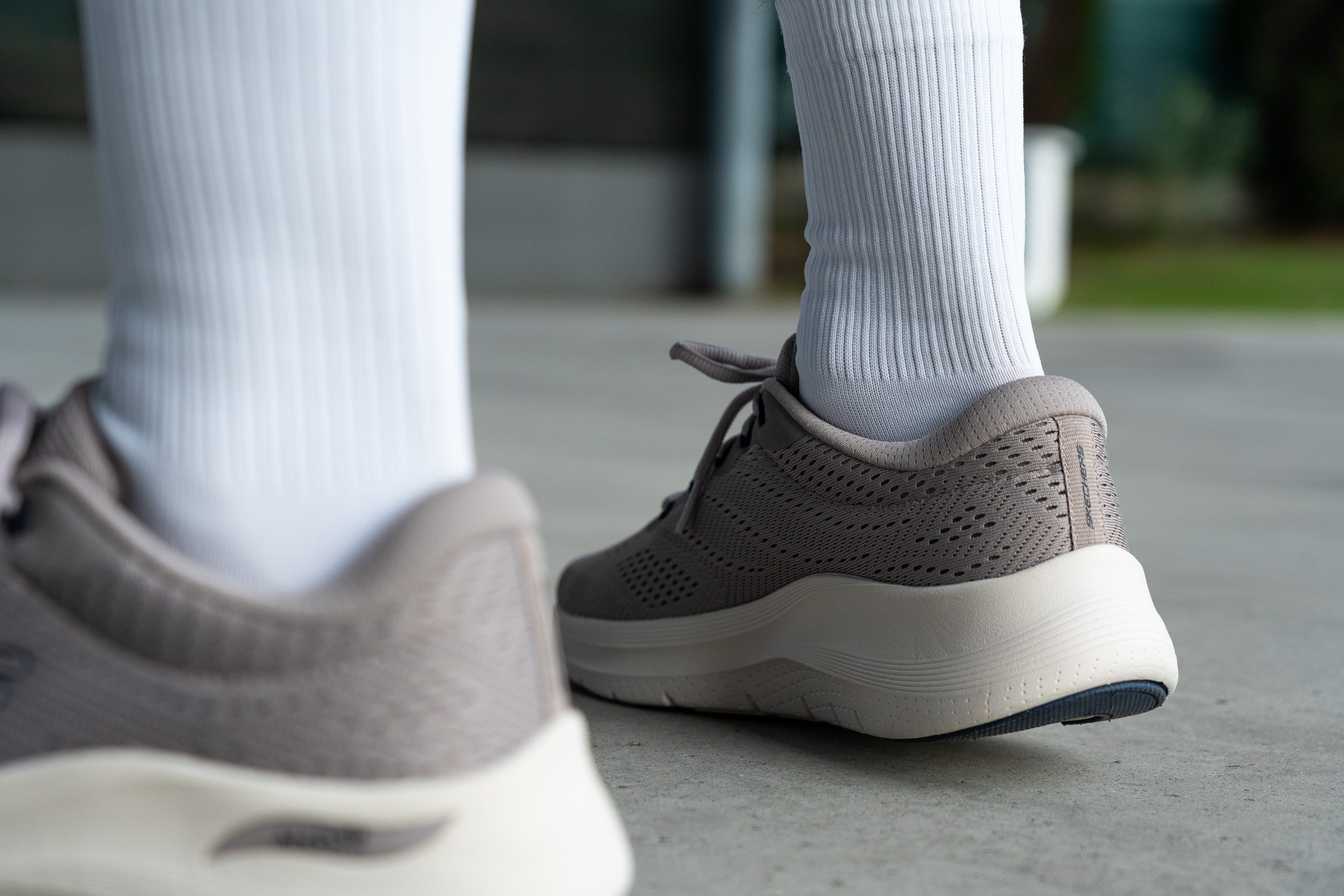
| Arch Fit 2.0 | None |

